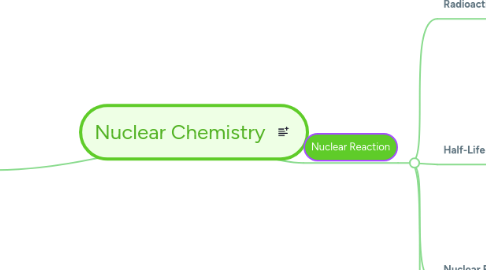
1. Important Terms related to Nuclear Chemistry
1.1. Isotope
1.1.1. Atoms of the same element having a different number of neutrons.
1.2. Radioactive Isotope
1.2.1. Also called radioisotope, is an unstable and spontaneously emits radiation to form a more stable nucleus.
1.3. Nuclear Radiation
1.3.1. The energy particles or rays that are given off from a radioactive element, such as uranium, as it decays.
1.4. Radioactivity
1.4.1. The nuclear radiation that is emitted by a Radioactive Isotope.
1.4.2. The most common unit of measurement for Radioactivity is Curie, which is also derived into smaller units such as Microcurie or Millicurie.
1.4.2.1. The becquerel is an Si unit and is also used to measure radioactivity.
1.4.2.2. The unit used to measure the radiation in the human body is called "Sieverts".
1.5. Electron Capture
1.5.1. The process on which an electron in an atom's shell is drawn into the nucleus where it combines with a proton, forming a neutron and a neutrino.
1.6. Geiger Counter
1.6.1. A small portable device used for measuring radioactivity.
2. Nuclear Reaction
2.1. Radioactive Decay
2.1.1. The process by which an unstable radioactive nucleus emits radiation, thereby forming a nucleus of new composition.
2.1.1.1. Kinds of Radioactive Decay
2.1.1.1.1. Alpha Emission
2.1.1.1.2. Beta Emission
2.1.1.1.3. Positron Emission
2.1.1.1.4. Gamma Emision
2.2. Half-Life
2.2.1. The Half-Life of a Radioactive Isotope is the total amount of time it takes for 1/2 of the sample to decay.
2.3. Nuclear Fission
2.3.1. This process is the splitting part of a heavy nucleus into lighter nuclei and neutrons.
2.3.1.1. Chain reaction
2.3.1.1.1. Each neutron produced during a nuclear fission can go on to bombard three other nuclei(uranium-235) to produce more nuclei and more neutrons. This process is called a "Chain Reaction".
2.3.1.1.2. Critical Mass
2.4. Nuclear Fusion
2.4.1. The process is the joining together of two light nuclei into lighter nuclei and neutrons.
